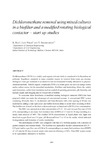Mostrar o rexistro simple do ítem
Dichloromethane removal using mixed cultures in a biofilter and a modified rotating biological contactor -start up studies
| dc.contributor.author | Ravi, R. | es_ES |
| dc.contributor.author | Philip, Ligy | es_ES |
| dc.contributor.author | Swaminathan, T. | es_ES |
| dc.date.accessioned | 2014-10-01T10:17:00Z | |
| dc.date.available | 2014-10-01T10:17:00Z | |
| dc.date.issued | 2007 | es_ES |
| dc.identifier.citation | Biotechniques for Air Pollution Control II, 2007: 469-476. ISBN: 978-84-9749-258-4 | es_ES |
| dc.identifier.isbn | 978-84-9749-258-4 | es_ES |
| dc.identifier.uri | http://hdl.handle.net/2183/12842 | |
| dc.description.abstract | [Abstract] Dichloromethane (DCM) is a widely used organic solvent which is considered to be hazardous air pollutant. Regulatory standards in many countries require its removal from waste gas streams. Biological waste gas treatment is an attractive and environmental-friendly alternative to physicochemical methods. Volatile organic compounds (VOCs) in waste gases can serve as energy source and/or carbon source for the microbial metabolism. Biofilters and biotrickling filters, the widely used bioreactors, suffer from limitations such as control of operating parameters, pH, humidity and nutrient supply and clogging due to overgrowth of biofilm. To overcome these drawbacks, a modified rotating biological contactor (RBC) has been proposed which can retain the advantages of conventional systems. A conventional RBC system containing 20 acrylic discs 21 cm diameter and 5mm thickness with a disc spacing of 10 mm was modified by adding a leak tight cover and baffles between disks to avoid short circuiting of flow. The biofilm was formed on the discs with inoculum pre acclimatized to DCM at low concentration. The RBC was operated at an inlet concentration of 0.15 – 0.2 g/m3 at a gas flow rate of 0.06 m3/h corresponding to an empty bed residence time (EBRT) of 2.5 min for 38 days resulting in a steady state removal of 84%. The residual DCM concentration in liquid phase was 5ppm and dissolved oxygen level was 3-4 ppm. pH decreased from 7 to 4.5 in the media, which indicated biodegradation and formation of acidic metabolites. The performance of RBC was compared with that of a biofilter packed with a mixture of garden compost and ceramic beads. The biofilter was operated at an inlet concentration of 0.15 – 0.21 g/m3 and at a gas flow rate of 0.06 m3/h corresponding to an empty bed residence time (EBRT) of 1.47 min for 90 days to reach steady state removal efficiency of 88%. Thus RBC system seems to be a potentially alternative to biofilter. | es_ES |
| dc.language.iso | eng | es_ES |
| dc.publisher | Universidade da Coruña | es_ES |
| dc.title | Dichloromethane removal using mixed cultures in a biofilter and a modified rotating biological contactor -start up studies | es_ES |
| dc.type | info:eu-repo/semantics/conferenceObject | es_ES |
| dc.rights.access | info:eu-repo/semantics/openAccess | es_ES |






